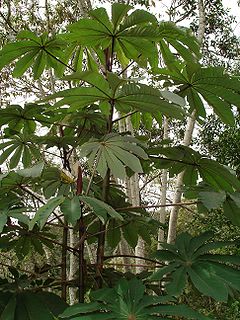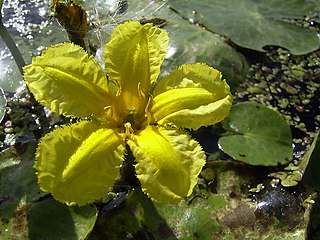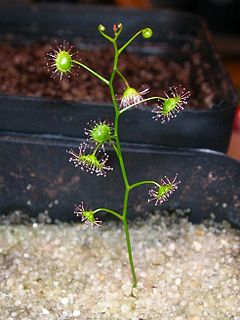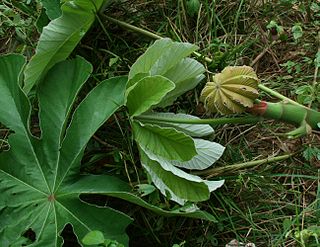
Cecropia is a Neotropical genus consisting of 61 recognized species with a highly distinctive lineage of dioecious trees. The genus consists of pioneer trees in the more or less humid parts of the Neotropics, with the majority of the species being myrmecophytic. Berg and Rosselli state that the genus is characterized by some unusual traits: spathes fully enclosing the flower-bearing parts of the inflorescences until anthesis, patches of dense indumentums (trichilia) producing Mullerian (food) at the base of the petiole, and anthers becoming detached at anthesis. Cecropia is most studied for its ecological role and association with ants. Its classification is controversial; in the past, it has been placed in the Cecropiaceae, Moraceae, or Urticaceae. The modern Angiosperm Phylogeny Group system places the "cecropiacean" group in the Urticaceae.

Mouthbrooding, also known as oral incubation and buccal incubation, is the care given by some groups of animals to their offspring by holding them in the mouth of the parent for extended periods of time. Although mouthbrooding is performed by a variety of different animals, such as the Darwin's frog, fishes are by far the most diverse mouthbrooders. Mouthbrooding has evolved independently in several different families of fish.

Drosera peltata, commonly called the shield sundew or pale sundew, is a climbing or scrambling perennial tuberous species in the carnivorous plant genus Drosera. Among the tuberous sundews, D. peltata has the largest distribution, which includes eastern and western Australia, New Zealand, India, and most of Southeast Asia including the Philippines. The specific epithet is Latin for "shield shaped", a reference to the shape of the cauline leaves. It is either a single extremely variable species, or a complex of several closely related species of uncertain taxonomic boundaries. In Australia at least four forms have had or still have specific taxonomic recognition: Drosera peltata subsp. peltata, D. peltata subsp. auriculata, D. foliosa and D. gracilis.

The Ariidae or ariid catfish are a family of catfish that mainly live in marine waters with many freshwater and brackish water species. They are found worldwide in tropical to warm temperate zones. The family includes about 143 species.

Lallemantia is a genus of flowering plants in the family Lamiaceae. It is named after the German botanist Julius Léopold Eduard Avé-Lallemant.

Darmera peltata, the Indian rhubarb or umbrella plant, is a flowering plant, the only species within the genus Darmera in the family Saxifragaceae. It is a slowly spreading rhizomatous perennial native to mountain streamsides in woodland in the western United States, growing to 2 m tall by 1 m wide. The name Darmera honours Karl Darmer, a German horticulturist from 19th century.
Helicia peltata is a species of plant in the family Proteaceae. It is endemic to Papua New Guinea. It is threatened by habitat loss.
Shorea peltata is a species of plant in the family Dipterocarpaceae. It is a tree found in Sumatra, Peninsular Malaysia and Borneo.

Nymphoides peltata is perennial, rooted aquatic plant with floating leaves of the family Menyanthaceae.

Nepenthes peltata is a tropical pitcher plant known only from the upper slopes of Mount Hamiguitan on the island of Mindanao in the Philippines. It is characterised by a peltate tendril attachment and conspicuous indumentum. The species typically produces ovoid pitchers with a prominent basal crest and large nectar glands on the lower surface of the lid.

Nasa is a genus of plants in the family Loasaceae containing over 100 known species, all of which are found in South America with the exception of two species endemic to Central America. They are common in submontane to montane environments.

Drosera bicolor is an erect perennial tuberous species in the genus Drosera that is endemic to Western Australia. It produces a basal rosette of leaves similar to that of D. peltata and the stem grows to 11 cm (4 in) high. Its white flowers that have a red spot near the petal base emerge from September to October. D. bicolor grows in deep silica sand on heathland along the upper Phillips River and south-east of Lake King.

Drosera sect. Ergaleium is a section of 26 species that are erect or scrambling tuberous plants in the genus Drosera. This section represents a natural group and are taxonomically monophyletic.

Cecropia peltata is a fast-growing tree in the genus Cecropia. Common names include trumpet tree and snakewood. It is listed as one of the world's 100 worst invasive alien species.

Nepenthes hamiguitanensis is a tropical pitcher plant endemic to a single peak on the Philippine island of Mindanao, where it grows at elevations of 1200–1600 m above sea level. Once thought to be a natural hybrid between N. micramphora and N. peltata, this plant is now considered a species of possible hybridogenic origin. It produces squat upper pitchers that vary greatly in pigmentation, from red speckled to yellow throughout.
Dendrocnide peltata, commonly known simply as the stinging tree or jelaton, is a large tree in the nettle family Urticaceae. With the other species of the genus Dendrocnide, it is known for the stinging hairs which cover the whole plant and cause severe pain when touched. The specific epithet comes from the Latin pelta, referring to the peltate leaves.

Prothysana is a genus of moths of the family Bombycidae. It contains two species, whose larvae are known as shag-carpet caterpillars. They are found from Mexico, south to Panama and into South America, at least to Ecuador.
The Mayan sea catfish, also known as the Mayan catfish or the Maya sea catfish, is a species of sea catfish in the family Ariidae. It was described by Albert Günther in 1864, originally under the genus Arius. It is found in tropical brackish and freshwater bodies in Belize, Costa Rica, Guatemala, Honduras, Mexico, Nicaragua, and Panama. It can reach a maximum total length of 35 cm (14 in), but more commonly reaches a TL of 25 cm (9.8 in).

The Blue sea catfish, also known as the widehead sea catfish, is a species of sea catfish in the family Ariidae. It was described by Albert Günther in 1864, originally under the genus Arius. It is found in tropical marine, brackish and freshwater along the Pacific coast in Central America, ranging from Mexico to Panama as well as Nicaragua. It dwells at a depth range of 0 to 20 m. It reaches a maximum total length of 37 cm (15 in).

Nepenthes justinae is a tropical pitcher plant known only from Mount Hamiguitan on the Philippine island of Mindanao, where it grows at elevations of 1000–1620 m above sea level.

















